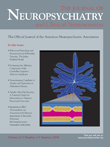Self-Induced “Therapeutic Seizures” for the Treatment of Depression
To the Editor: Early 20th century research postulated an antagonism between epilepsy and psychosis, leading von Meduna 1 to introduce convulsive therapy for schizophrenia. Although modern research questions this postulate, there is a complex and understudied interplay between seizures and behavioral disorders. I report on a woman with epilepsy who used self-induced seizures to treat her depression.
Case Report
A 43-year-old woman was diagnosed with epilepsy at age 29. She experienced 6–8 complex-partial or generalized tonic-clonic seizures per month for many years, failing to respond to a range of anticonvulsant drugs. However, when she was treated with a combination therapy of phenytoin (300 mg/day) and gabapentin (1600 mg/day), her seizures were completely suppressed. Regrettably, after 6 months without seizures, she noticed the onset of depression. Her personality underwent a profound change; she became sad, feeling that life was no longer worth living. She had trouble sleeping and had early morning awakening. Food lost its taste and she lost weight. Although she was depressed, there were no symptoms of psychosis. Her family confirmed the marked change in her mood. Although she had experienced some depressive episodes in her early 20s, since developing epilepsy she had been a happy, positive-thinking person, despite the personal difficulties arising from her seizure disorder.
Several antidepressants were tried, but none were of benefit; she remained depressed for more than a year. Ultimately, due to the depression, she quit taking her anticonvulsants stating that “life just is not worth it.” This led to a series of complex partial and generalized tonic-clonic seizures, after which her mood promptly became cheerful and optimistic again. She felt that seizures had done more for her mood than the antidepressant drugs. She was restarted on phenytoin and gabapentin, but did not receive any further antidepressants. After several years of unsupervised self-experimentation, she disclosed a new approach to her seizure disorder. She would abruptly stop taking gabapentin for five consecutive days during the last week of every fourth month. This would result in her having several complex-partial and generalized tonic-clonic seizures (at 3–4 days postwithdrawal); she did not disclose these periodic seizures to family or friends. Since embarking upon this strategy of self-induced “therapeutic seizures,” her depression had completely resolved.
Discussion
In the 1950s, Landolt 2 observed people with epilepsy who became psychotic when their seizures were controlled—an observation which he attributed to the electroencephalographic phenomenon of “forced normalization.” Conversely, Tellenbach 3 used the term “alternative psychoses” to describe people whose psychosis resolved with the return of seizures. Although these notions are now regarded as outdated and inaccurate, there is a close biological link between seizures and psychiatric (not necessarily psychotic) disorders.
This case demonstrates the relationship between seizures and depression. In particular, it demonstrates that the dynamic neurochemical milieu of the postseizure state may exhibit prolonged anticonvulsant properties. Postseizure increases in brain levels of dopamine and serotonin, as well as alterations in norepinephrine metabolism, have been consistently observed in animal models of epilepsy. 4 , 5 Analogously, studies concerning the use of electroconvulsive seizures to treat depression likewise reveal increased release of norepinephrine and increased serotonergic activity (including upregulated 5-HT 2a receptors and increased 5-HT 2a mRNA levels) in the postseizure state. 6 Since such neurochemical changes have antidepressant effects, it is reasonable to assert that “naturally occurring” seizures also produce antidepressant effects.
Although abrupt alterations in anticonvulsant dosing cannot be recommended, this woman with epilepsy used periodic self-induced seizures precipitated by intermittent medication withdrawal to treat her depression.
1. von Meduna L: Versuche ueber die biologische beeintlussung des ablaufes der schizophrenia. I. campher- und cadiazolkraempfe. Z Ges Neurol Psychiatr 1935; 152:235–262Google Scholar
2. Landolt H: Some clinical EEG correlations in epileptic psychoses. Electroencephalogr Clin Neurophysiol 1953; 5:121Google Scholar
3. Tellenbach H: Epilepsie als anfallsleiden und als psychose. Ueber alternative Psychosen paranoider pragung bei “forcierter Normalisierung” (Landolt) des Electroencephalogramms Epileptischer. Nervenarzt 1965; 36:190–202Google Scholar
4. Meurs A, Clinckers R, Ebinger G, et al: Seizure activity and changes in hippocampal extracellular glutamate, GABA, dopamine and serotonin. Epilepsy Res 2008; 78:50–59Google Scholar
5. Cavalheiro EA, Fernandes MJ, Turski L, et al: Spontaneous recurrent seizures in rats: amino acid and monoamine determination in the hippocampus. Epilepsia 1994; 35:1–11Google Scholar
6. Grover S, Mattoo SK, Gupta N: Theories of mechanism of action of electroconvulsive therapy. German J Psychiatry 2005; 8:70–84Google Scholar



